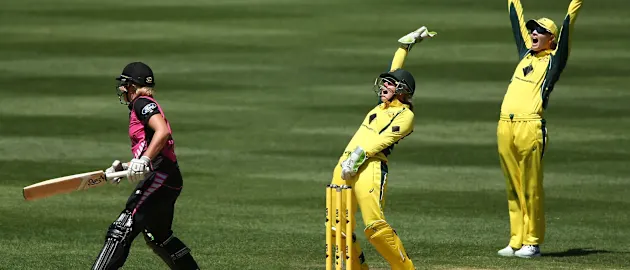To review or not to review? The decision is out


“I’m a wicket-keeper, so everything is definitely out!” Katey Martin, who wears the big gloves for New Zealand Women, laughs. “Most people have either edged the ball or are plumb lbw!”
Martin was joking, but on a more serious note, she knows that she’ll have to rein in the exuberance and be more attentive behind the stumps this ICC Women’s World T20 2018. As a wicket-keeper, her captain and the bowlers will be looking to her to help them make the right calls when deciding whether to use the Decision Review System or not.
Pakistan captain Javeria Khan on ICC WWT20 2018 being a standalone event
The 2018 edition of the Women’s World T20, starting in the Caribbean on 9 November, will mark the first time that DRS has been introduced for all games of a women’s global tournament. In the ICC Women’s World Cup 2017, it had been available for some matches.
“I think it’s really good for the women’s game and a step up to put us parallel to men’s cricket,” said Chamari Athapaththu, the Sri Lanka captain, welcoming the move.
The players, however, aren’t yet fully comfortable with the system. In fact, for many of them, it will be their first time using it.
“It’s something that we have to learn pretty quickly,” said Amy Satterthwaite, the New Zealand skipper, quipping, “Hopefully we will have a slightly better [DRS] record than our male counterparts!”
“We’re not experienced with it at all,” said Dane van Niekerk, the South Africa captain. “This will be my first time. I think Lizelle [Lee] is the only one who used it and she used it for the opposite reason – I think it was the semi-final – she thought she hit the ball, but actually she didn’t hit the ball and it missed the stump.”
WT20 2018: Dane van Niekerk on using DRS for the first time
To cope with the new tool at their disposal, van Niekerk said she was trying to keep her bowlers calm. “It's going to be a new experience, but we’re excited for that. In the past we felt like we got a few hard ones. So hopefully we can use the DRS to our benefit.”
"We haven't really practised it," admitted Pakistan's Bismah Maroof. "We only know what we've seen on TV from the men's games, that the bowler and 'keeper will have a main role. We'll tell them to be sensible! And maybe the captain and short-cover, mid-on and mid-off fielders can contribute."
New Zealand, meanwhile, hoped to use the warm-up games to identify those situations when they might challenge a decision.
TEAM PREVIEW: SOUTH AFRICA 🇿🇦
— T20 World Cup (@T20WorldCup) November 4, 2018
Why the Proteas are one of the favourites heading into the ICC Women's #WT20.
READ 👇https://t.co/Uu70gs3BUg pic.twitter.com/NRgjqyfMMD
“The warm-up games are actually an opportunity for us to practice [DRS] in a way,” said Satterthwaite. “Even though you aren’t going to be able to send it upstairs, the process we are going to follow as both batters and in the field is something we have talked about and we want to implement in these warm-up games, to ensure we aren’t going into our first match completely cold.”
“I’ll be talking closely to Amy,” added Martin, stressing that communication would be key. “She might have to reign me in a little bit. I’ll work with the bowler and Amy not to rush into any decisions and have a chat about what is right.”
